University Report: The Detrimental Effects of Fast Food Consumption
VerifiedAdded on 2023/05/28
|9
|1909
|186
Report
AI Summary
This report, addressing the negative effects of fast food consumption, begins by identifying the target audience and the research's purpose: to highlight and prevent the adverse health impacts associated with fast food intake. The introduction emphasizes the importance of a balanced diet and the nutritional deficiencies often found in fast food, which is high in sugar, fat, and calories, while being low in essential nutrients. The research aims to discuss these negative effects, with objectives including assessing the impact of fast food on individual health, analyzing eating behaviors across different age groups, and evaluating awareness of fast food's effects on children. The literature review examines various types of fast food, such as pizza and hamburgers, and discusses the rise of fast-food companies. The core of the report details the negative health consequences of fast food, including a lack of energy, poor concentration, high cholesterol levels, heart disease, low nutritional value, high levels of chemical additives, and a lack of oxygen supply. The conclusion emphasizes the rising consumption of fast food and its link to obesity and other health problems, advocating for education to promote healthier eating habits.
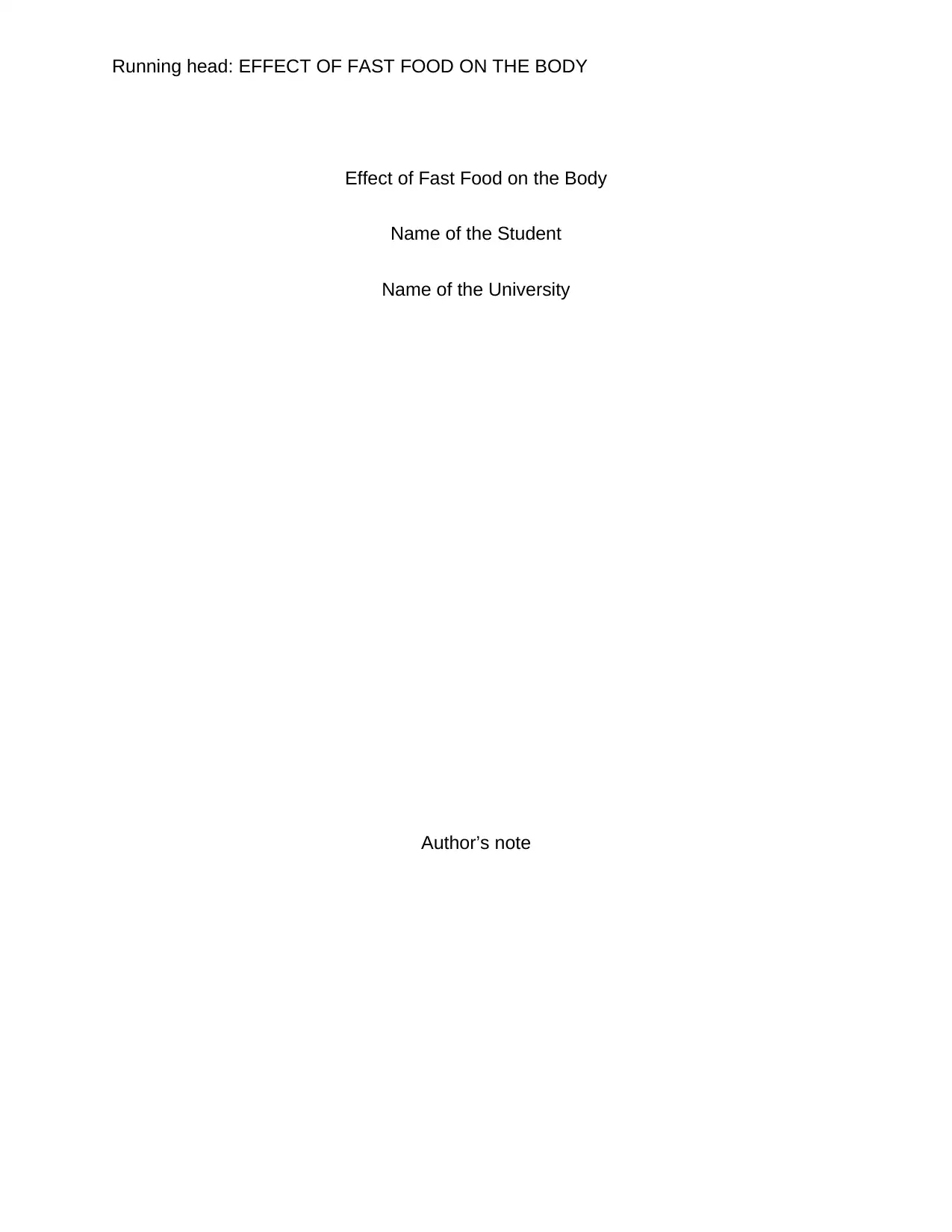
Running head: EFFECT OF FAST FOOD ON THE BODY
Effect of Fast Food on the Body
Name of the Student
Name of the University
Author’s note
Effect of Fast Food on the Body
Name of the Student
Name of the University
Author’s note
Paraphrase This Document
Need a fresh take? Get an instant paraphrase of this document with our AI Paraphraser
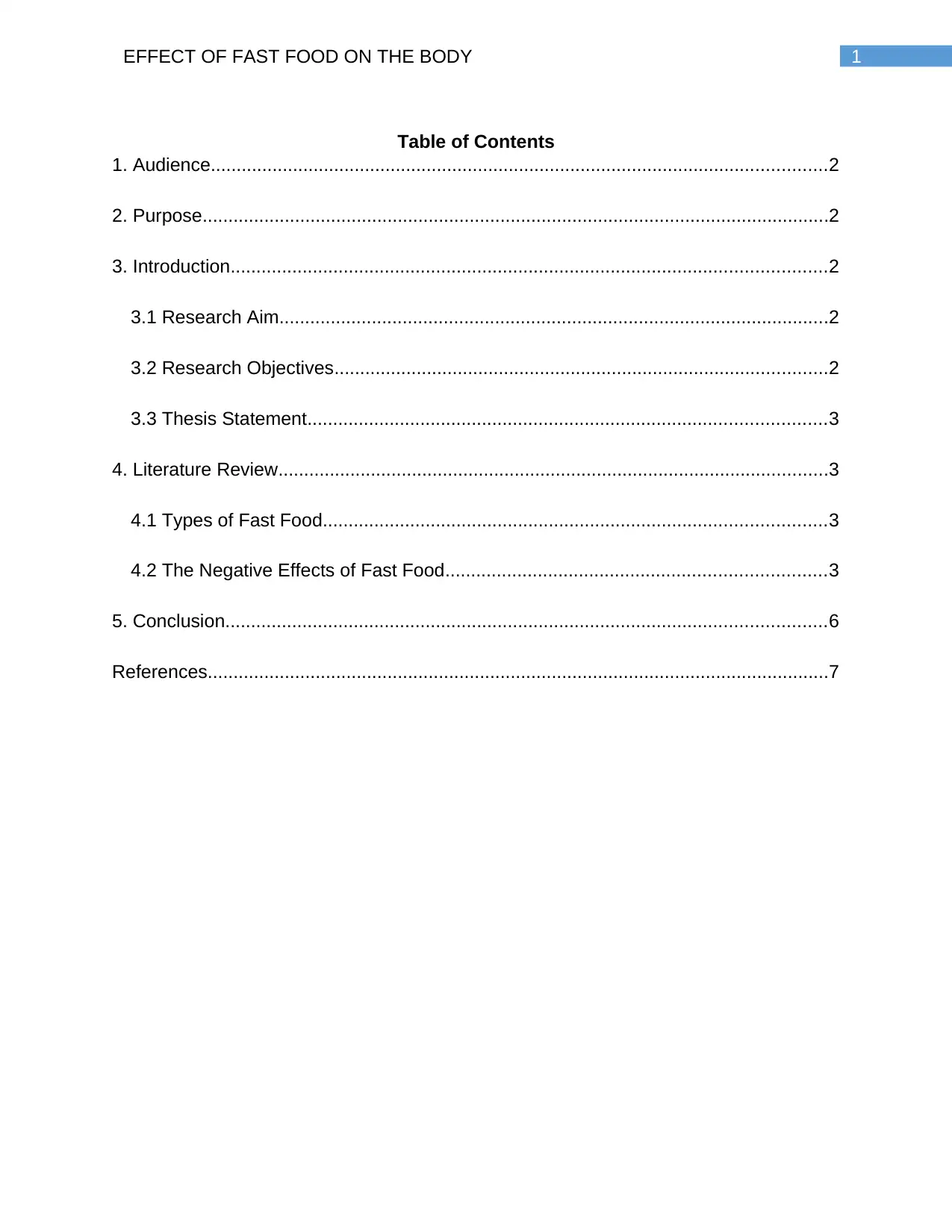
1EFFECT OF FAST FOOD ON THE BODY
Table of Contents
1. Audience........................................................................................................................2
2. Purpose..........................................................................................................................2
3. Introduction....................................................................................................................2
3.1 Research Aim...........................................................................................................2
3.2 Research Objectives................................................................................................2
3.3 Thesis Statement.....................................................................................................3
4. Literature Review...........................................................................................................3
4.1 Types of Fast Food..................................................................................................3
4.2 The Negative Effects of Fast Food..........................................................................3
5. Conclusion.....................................................................................................................6
References.........................................................................................................................7
Table of Contents
1. Audience........................................................................................................................2
2. Purpose..........................................................................................................................2
3. Introduction....................................................................................................................2
3.1 Research Aim...........................................................................................................2
3.2 Research Objectives................................................................................................2
3.3 Thesis Statement.....................................................................................................3
4. Literature Review...........................................................................................................3
4.1 Types of Fast Food..................................................................................................3
4.2 The Negative Effects of Fast Food..........................................................................3
5. Conclusion.....................................................................................................................6
References.........................................................................................................................7
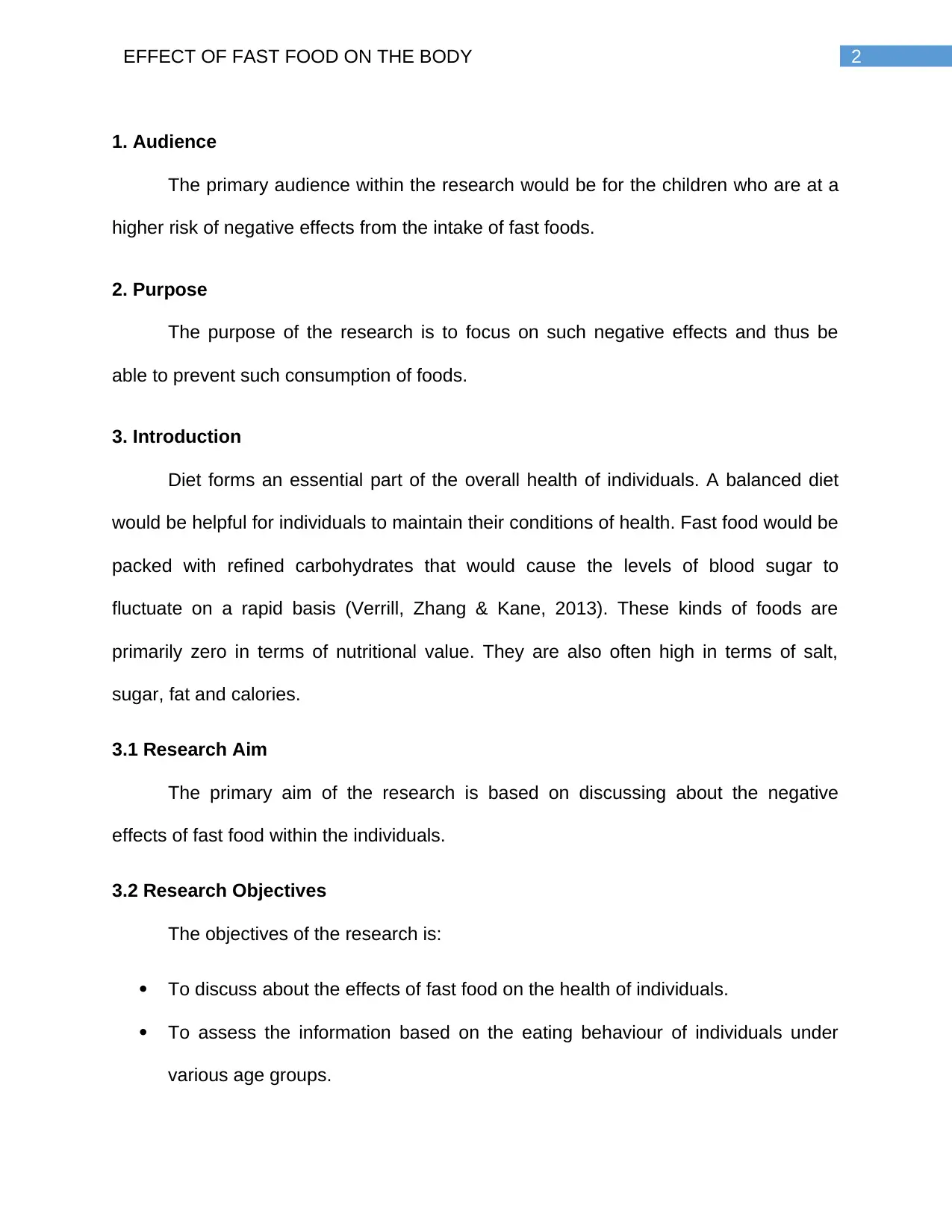
2EFFECT OF FAST FOOD ON THE BODY
1. Audience
The primary audience within the research would be for the children who are at a
higher risk of negative effects from the intake of fast foods.
2. Purpose
The purpose of the research is to focus on such negative effects and thus be
able to prevent such consumption of foods.
3. Introduction
Diet forms an essential part of the overall health of individuals. A balanced diet
would be helpful for individuals to maintain their conditions of health. Fast food would be
packed with refined carbohydrates that would cause the levels of blood sugar to
fluctuate on a rapid basis (Verrill, Zhang & Kane, 2013). These kinds of foods are
primarily zero in terms of nutritional value. They are also often high in terms of salt,
sugar, fat and calories.
3.1 Research Aim
The primary aim of the research is based on discussing about the negative
effects of fast food within the individuals.
3.2 Research Objectives
The objectives of the research is:
To discuss about the effects of fast food on the health of individuals.
To assess the information based on the eating behaviour of individuals under
various age groups.
1. Audience
The primary audience within the research would be for the children who are at a
higher risk of negative effects from the intake of fast foods.
2. Purpose
The purpose of the research is to focus on such negative effects and thus be
able to prevent such consumption of foods.
3. Introduction
Diet forms an essential part of the overall health of individuals. A balanced diet
would be helpful for individuals to maintain their conditions of health. Fast food would be
packed with refined carbohydrates that would cause the levels of blood sugar to
fluctuate on a rapid basis (Verrill, Zhang & Kane, 2013). These kinds of foods are
primarily zero in terms of nutritional value. They are also often high in terms of salt,
sugar, fat and calories.
3.1 Research Aim
The primary aim of the research is based on discussing about the negative
effects of fast food within the individuals.
3.2 Research Objectives
The objectives of the research is:
To discuss about the effects of fast food on the health of individuals.
To assess the information based on the eating behaviour of individuals under
various age groups.
⊘ This is a preview!⊘
Do you want full access?
Subscribe today to unlock all pages.

Trusted by 1+ million students worldwide
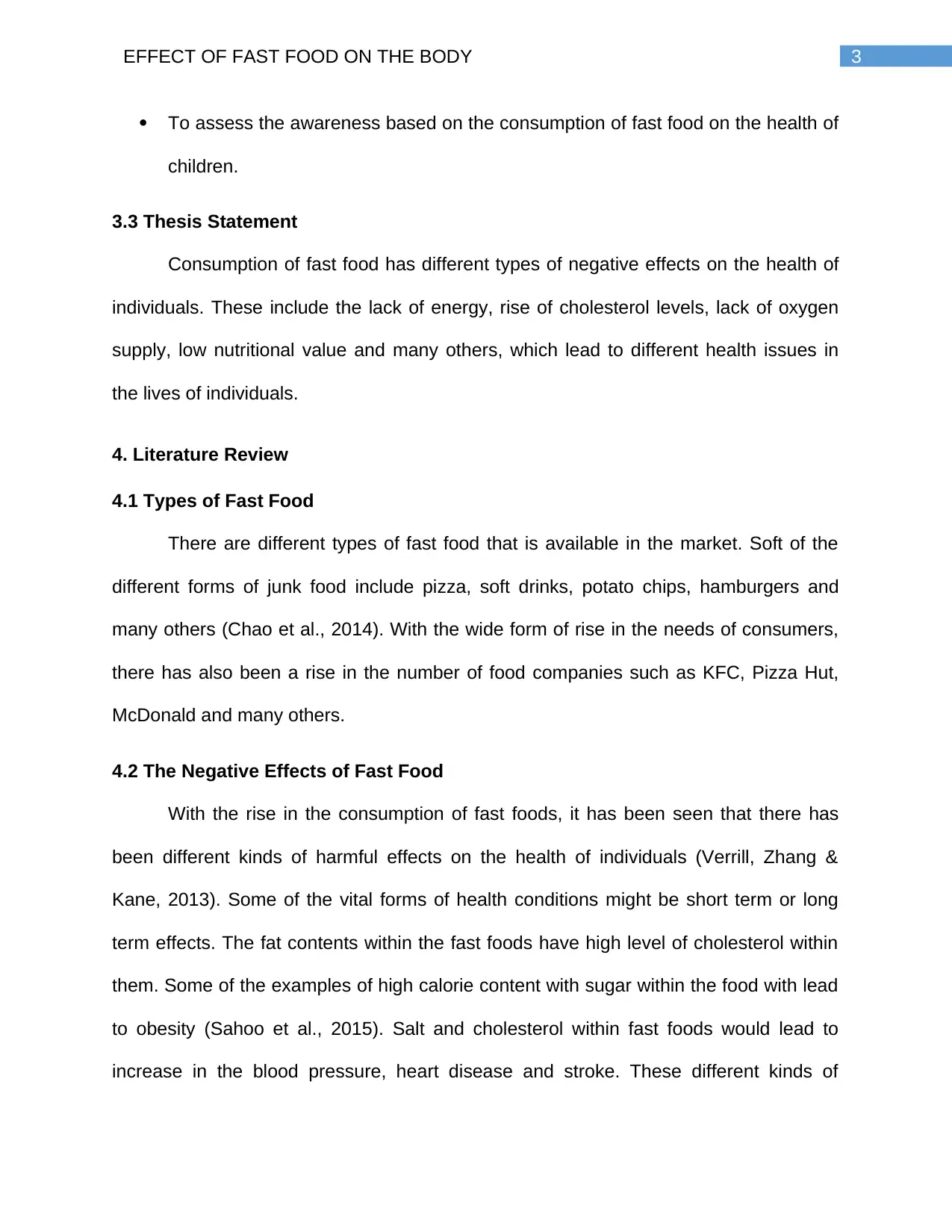
3EFFECT OF FAST FOOD ON THE BODY
To assess the awareness based on the consumption of fast food on the health of
children.
3.3 Thesis Statement
Consumption of fast food has different types of negative effects on the health of
individuals. These include the lack of energy, rise of cholesterol levels, lack of oxygen
supply, low nutritional value and many others, which lead to different health issues in
the lives of individuals.
4. Literature Review
4.1 Types of Fast Food
There are different types of fast food that is available in the market. Soft of the
different forms of junk food include pizza, soft drinks, potato chips, hamburgers and
many others (Chao et al., 2014). With the wide form of rise in the needs of consumers,
there has also been a rise in the number of food companies such as KFC, Pizza Hut,
McDonald and many others.
4.2 The Negative Effects of Fast Food
With the rise in the consumption of fast foods, it has been seen that there has
been different kinds of harmful effects on the health of individuals (Verrill, Zhang &
Kane, 2013). Some of the vital forms of health conditions might be short term or long
term effects. The fat contents within the fast foods have high level of cholesterol within
them. Some of the examples of high calorie content with sugar within the food with lead
to obesity (Sahoo et al., 2015). Salt and cholesterol within fast foods would lead to
increase in the blood pressure, heart disease and stroke. These different kinds of
To assess the awareness based on the consumption of fast food on the health of
children.
3.3 Thesis Statement
Consumption of fast food has different types of negative effects on the health of
individuals. These include the lack of energy, rise of cholesterol levels, lack of oxygen
supply, low nutritional value and many others, which lead to different health issues in
the lives of individuals.
4. Literature Review
4.1 Types of Fast Food
There are different types of fast food that is available in the market. Soft of the
different forms of junk food include pizza, soft drinks, potato chips, hamburgers and
many others (Chao et al., 2014). With the wide form of rise in the needs of consumers,
there has also been a rise in the number of food companies such as KFC, Pizza Hut,
McDonald and many others.
4.2 The Negative Effects of Fast Food
With the rise in the consumption of fast foods, it has been seen that there has
been different kinds of harmful effects on the health of individuals (Verrill, Zhang &
Kane, 2013). Some of the vital forms of health conditions might be short term or long
term effects. The fat contents within the fast foods have high level of cholesterol within
them. Some of the examples of high calorie content with sugar within the food with lead
to obesity (Sahoo et al., 2015). Salt and cholesterol within fast foods would lead to
increase in the blood pressure, heart disease and stroke. These different kinds of
Paraphrase This Document
Need a fresh take? Get an instant paraphrase of this document with our AI Paraphraser
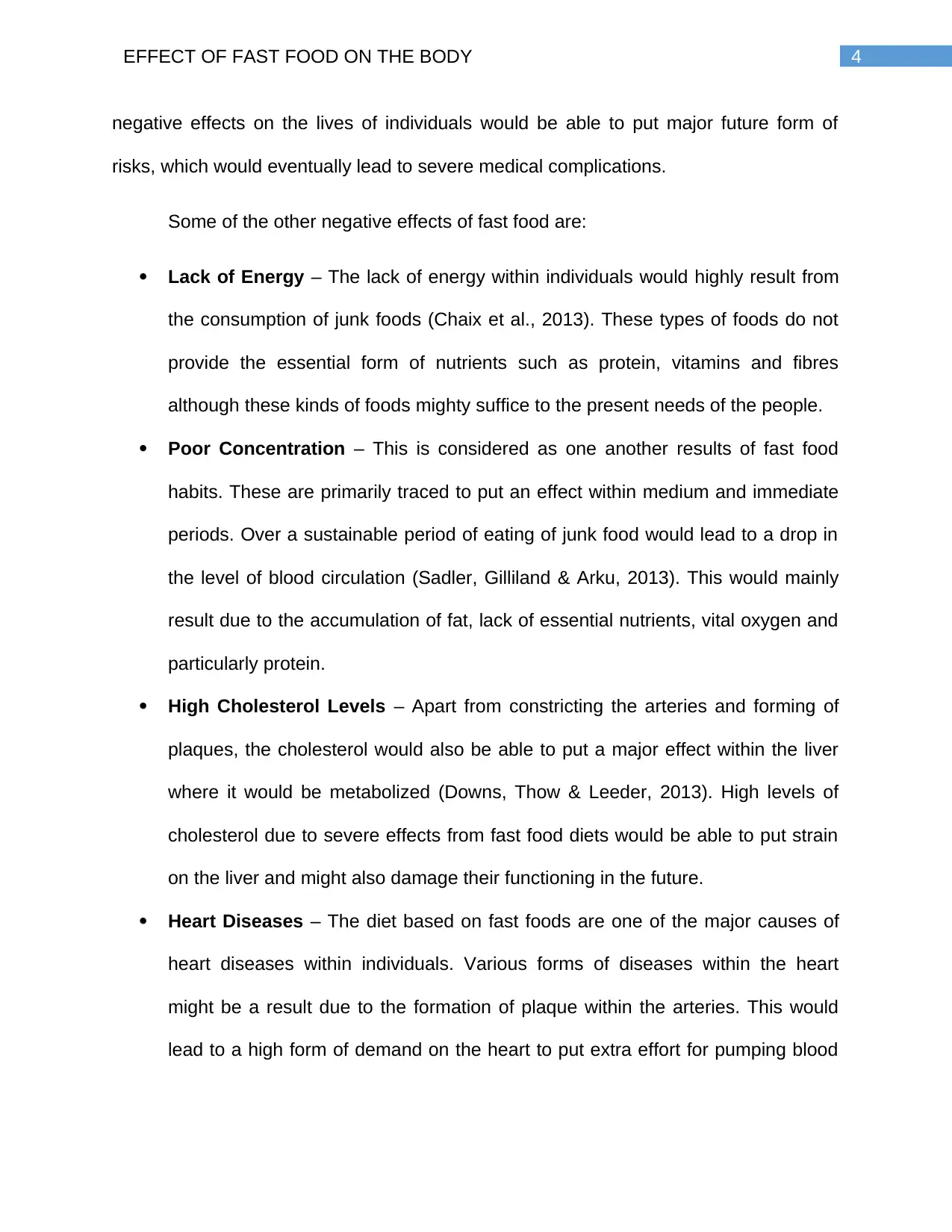
4EFFECT OF FAST FOOD ON THE BODY
negative effects on the lives of individuals would be able to put major future form of
risks, which would eventually lead to severe medical complications.
Some of the other negative effects of fast food are:
Lack of Energy – The lack of energy within individuals would highly result from
the consumption of junk foods (Chaix et al., 2013). These types of foods do not
provide the essential form of nutrients such as protein, vitamins and fibres
although these kinds of foods mighty suffice to the present needs of the people.
Poor Concentration – This is considered as one another results of fast food
habits. These are primarily traced to put an effect within medium and immediate
periods. Over a sustainable period of eating of junk food would lead to a drop in
the level of blood circulation (Sadler, Gilliland & Arku, 2013). This would mainly
result due to the accumulation of fat, lack of essential nutrients, vital oxygen and
particularly protein.
High Cholesterol Levels – Apart from constricting the arteries and forming of
plaques, the cholesterol would also be able to put a major effect within the liver
where it would be metabolized (Downs, Thow & Leeder, 2013). High levels of
cholesterol due to severe effects from fast food diets would be able to put strain
on the liver and might also damage their functioning in the future.
Heart Diseases – The diet based on fast foods are one of the major causes of
heart diseases within individuals. Various forms of diseases within the heart
might be a result due to the formation of plaque within the arteries. This would
lead to a high form of demand on the heart to put extra effort for pumping blood
negative effects on the lives of individuals would be able to put major future form of
risks, which would eventually lead to severe medical complications.
Some of the other negative effects of fast food are:
Lack of Energy – The lack of energy within individuals would highly result from
the consumption of junk foods (Chaix et al., 2013). These types of foods do not
provide the essential form of nutrients such as protein, vitamins and fibres
although these kinds of foods mighty suffice to the present needs of the people.
Poor Concentration – This is considered as one another results of fast food
habits. These are primarily traced to put an effect within medium and immediate
periods. Over a sustainable period of eating of junk food would lead to a drop in
the level of blood circulation (Sadler, Gilliland & Arku, 2013). This would mainly
result due to the accumulation of fat, lack of essential nutrients, vital oxygen and
particularly protein.
High Cholesterol Levels – Apart from constricting the arteries and forming of
plaques, the cholesterol would also be able to put a major effect within the liver
where it would be metabolized (Downs, Thow & Leeder, 2013). High levels of
cholesterol due to severe effects from fast food diets would be able to put strain
on the liver and might also damage their functioning in the future.
Heart Diseases – The diet based on fast foods are one of the major causes of
heart diseases within individuals. Various forms of diseases within the heart
might be a result due to the formation of plaque within the arteries. This would
lead to a high form of demand on the heart to put extra effort for pumping blood
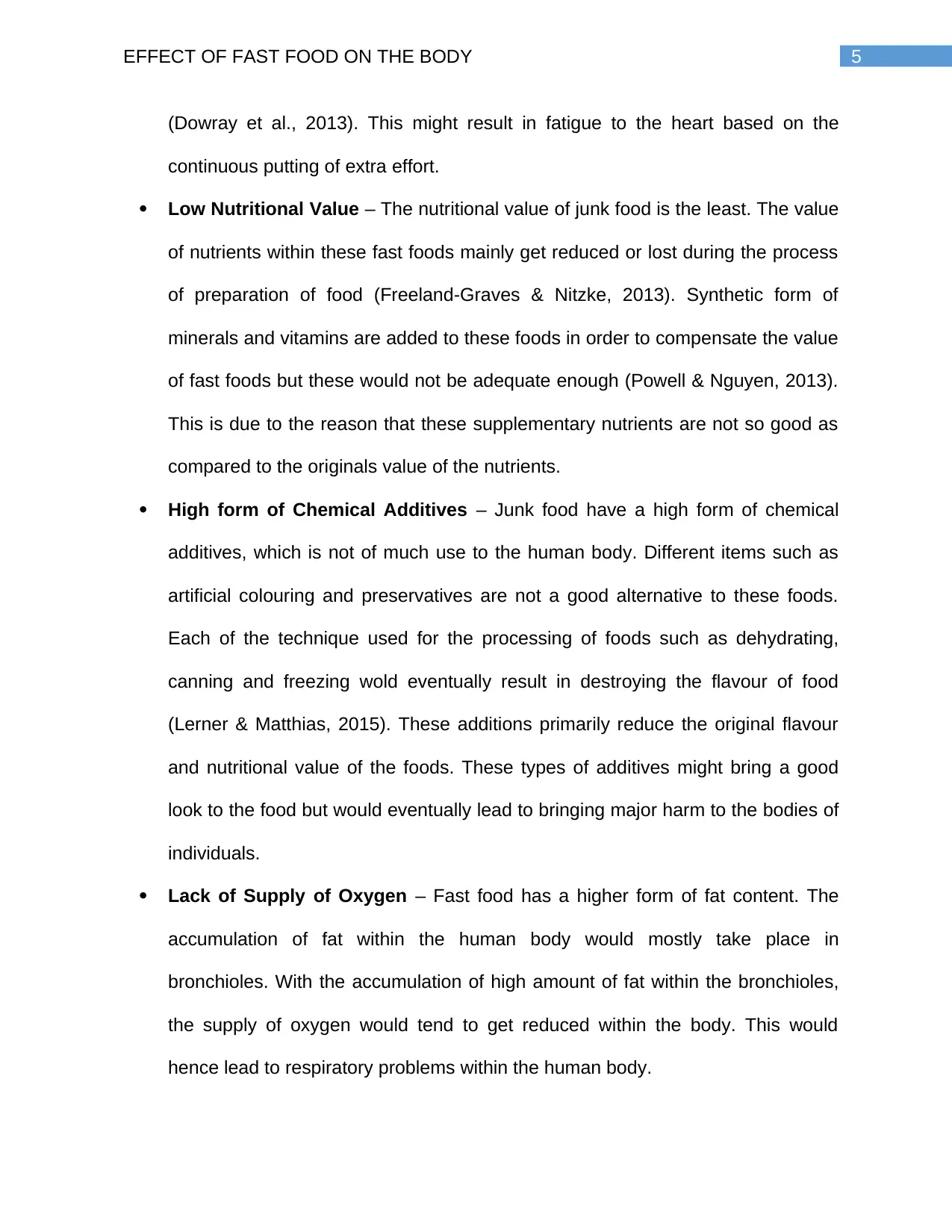
5EFFECT OF FAST FOOD ON THE BODY
(Dowray et al., 2013). This might result in fatigue to the heart based on the
continuous putting of extra effort.
Low Nutritional Value – The nutritional value of junk food is the least. The value
of nutrients within these fast foods mainly get reduced or lost during the process
of preparation of food (Freeland-Graves & Nitzke, 2013). Synthetic form of
minerals and vitamins are added to these foods in order to compensate the value
of fast foods but these would not be adequate enough (Powell & Nguyen, 2013).
This is due to the reason that these supplementary nutrients are not so good as
compared to the originals value of the nutrients.
High form of Chemical Additives – Junk food have a high form of chemical
additives, which is not of much use to the human body. Different items such as
artificial colouring and preservatives are not a good alternative to these foods.
Each of the technique used for the processing of foods such as dehydrating,
canning and freezing wold eventually result in destroying the flavour of food
(Lerner & Matthias, 2015). These additions primarily reduce the original flavour
and nutritional value of the foods. These types of additives might bring a good
look to the food but would eventually lead to bringing major harm to the bodies of
individuals.
Lack of Supply of Oxygen – Fast food has a higher form of fat content. The
accumulation of fat within the human body would mostly take place in
bronchioles. With the accumulation of high amount of fat within the bronchioles,
the supply of oxygen would tend to get reduced within the body. This would
hence lead to respiratory problems within the human body.
(Dowray et al., 2013). This might result in fatigue to the heart based on the
continuous putting of extra effort.
Low Nutritional Value – The nutritional value of junk food is the least. The value
of nutrients within these fast foods mainly get reduced or lost during the process
of preparation of food (Freeland-Graves & Nitzke, 2013). Synthetic form of
minerals and vitamins are added to these foods in order to compensate the value
of fast foods but these would not be adequate enough (Powell & Nguyen, 2013).
This is due to the reason that these supplementary nutrients are not so good as
compared to the originals value of the nutrients.
High form of Chemical Additives – Junk food have a high form of chemical
additives, which is not of much use to the human body. Different items such as
artificial colouring and preservatives are not a good alternative to these foods.
Each of the technique used for the processing of foods such as dehydrating,
canning and freezing wold eventually result in destroying the flavour of food
(Lerner & Matthias, 2015). These additions primarily reduce the original flavour
and nutritional value of the foods. These types of additives might bring a good
look to the food but would eventually lead to bringing major harm to the bodies of
individuals.
Lack of Supply of Oxygen – Fast food has a higher form of fat content. The
accumulation of fat within the human body would mostly take place in
bronchioles. With the accumulation of high amount of fat within the bronchioles,
the supply of oxygen would tend to get reduced within the body. This would
hence lead to respiratory problems within the human body.
⊘ This is a preview!⊘
Do you want full access?
Subscribe today to unlock all pages.

Trusted by 1+ million students worldwide
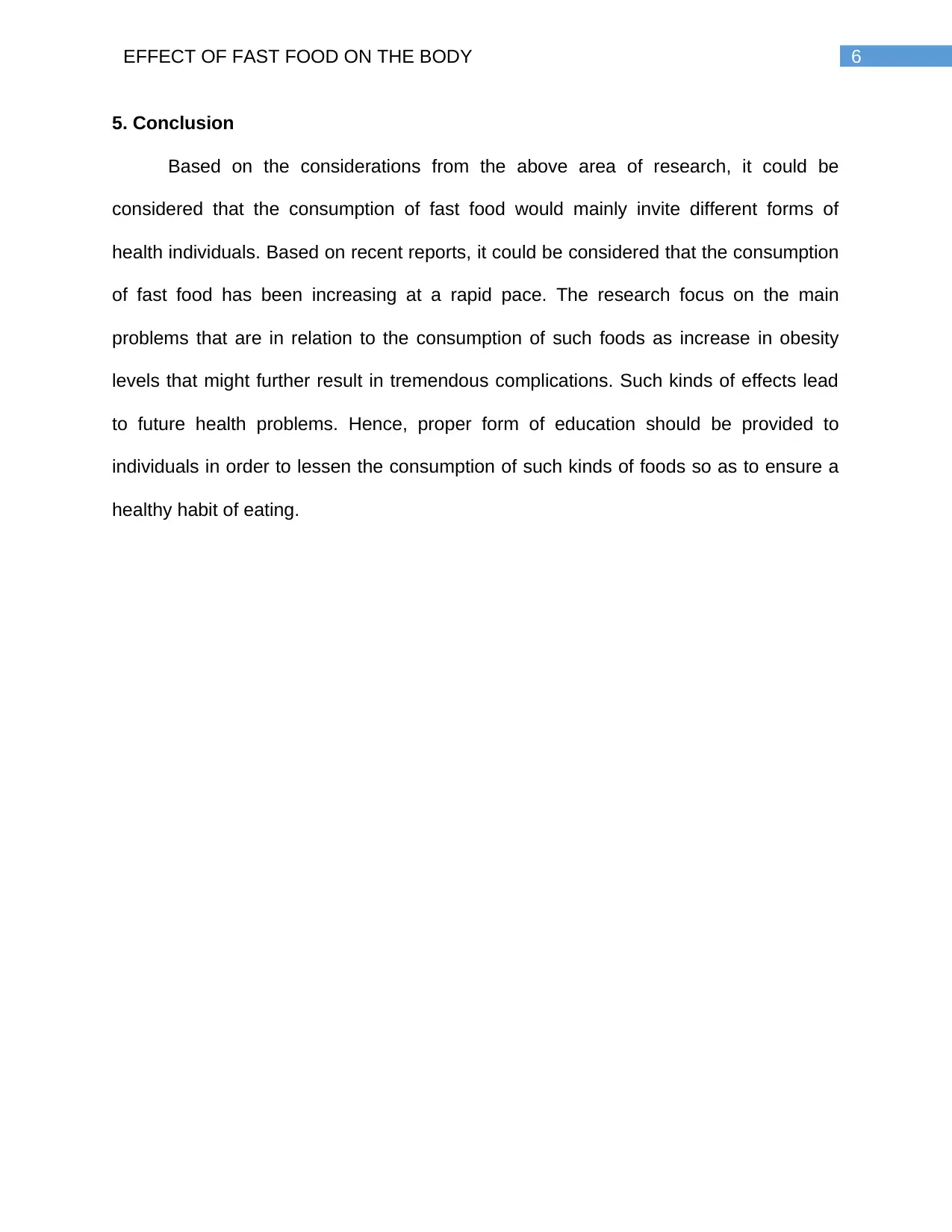
6EFFECT OF FAST FOOD ON THE BODY
5. Conclusion
Based on the considerations from the above area of research, it could be
considered that the consumption of fast food would mainly invite different forms of
health individuals. Based on recent reports, it could be considered that the consumption
of fast food has been increasing at a rapid pace. The research focus on the main
problems that are in relation to the consumption of such foods as increase in obesity
levels that might further result in tremendous complications. Such kinds of effects lead
to future health problems. Hence, proper form of education should be provided to
individuals in order to lessen the consumption of such kinds of foods so as to ensure a
healthy habit of eating.
5. Conclusion
Based on the considerations from the above area of research, it could be
considered that the consumption of fast food would mainly invite different forms of
health individuals. Based on recent reports, it could be considered that the consumption
of fast food has been increasing at a rapid pace. The research focus on the main
problems that are in relation to the consumption of such foods as increase in obesity
levels that might further result in tremendous complications. Such kinds of effects lead
to future health problems. Hence, proper form of education should be provided to
individuals in order to lessen the consumption of such kinds of foods so as to ensure a
healthy habit of eating.
Paraphrase This Document
Need a fresh take? Get an instant paraphrase of this document with our AI Paraphraser
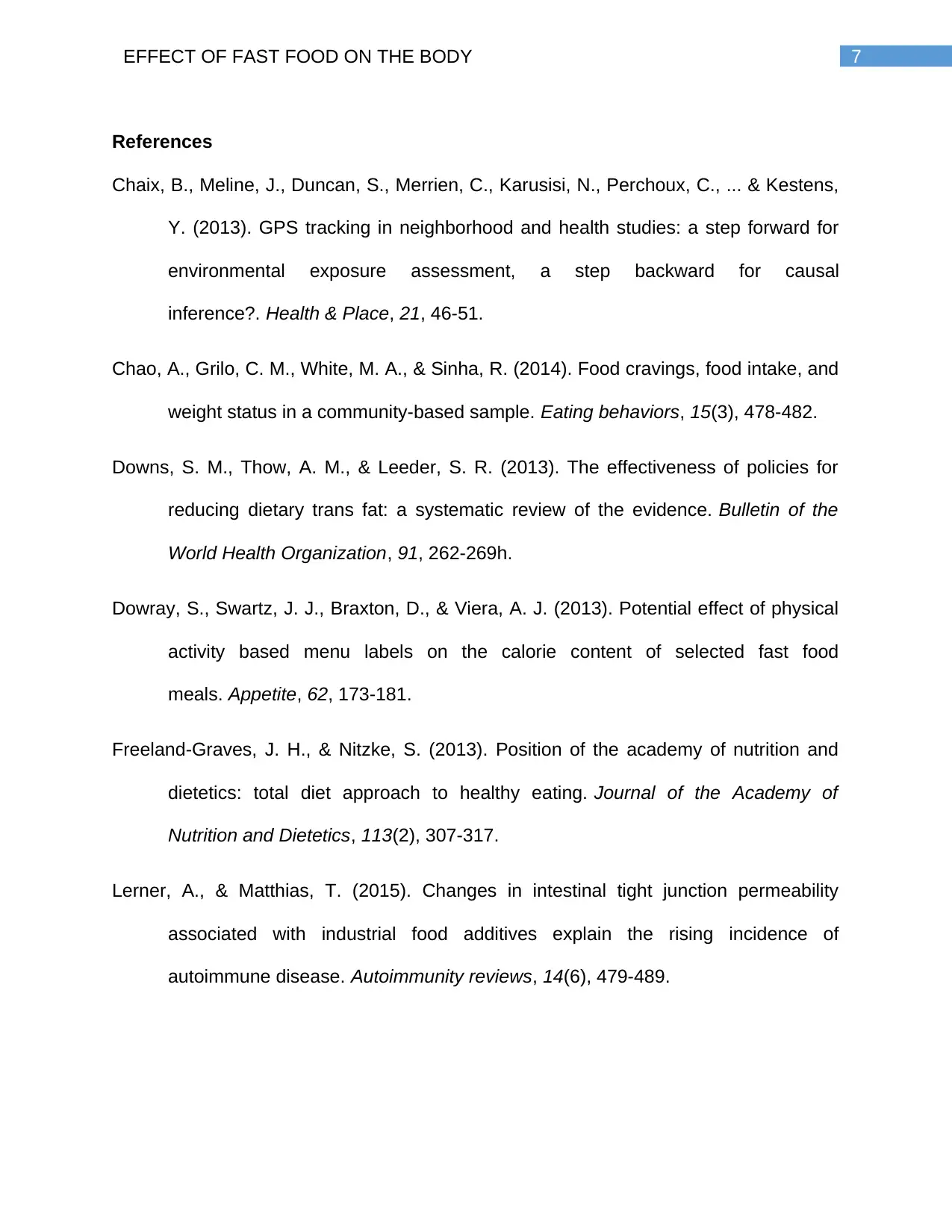
7EFFECT OF FAST FOOD ON THE BODY
References
Chaix, B., Meline, J., Duncan, S., Merrien, C., Karusisi, N., Perchoux, C., ... & Kestens,
Y. (2013). GPS tracking in neighborhood and health studies: a step forward for
environmental exposure assessment, a step backward for causal
inference?. Health & Place, 21, 46-51.
Chao, A., Grilo, C. M., White, M. A., & Sinha, R. (2014). Food cravings, food intake, and
weight status in a community-based sample. Eating behaviors, 15(3), 478-482.
Downs, S. M., Thow, A. M., & Leeder, S. R. (2013). The effectiveness of policies for
reducing dietary trans fat: a systematic review of the evidence. Bulletin of the
World Health Organization, 91, 262-269h.
Dowray, S., Swartz, J. J., Braxton, D., & Viera, A. J. (2013). Potential effect of physical
activity based menu labels on the calorie content of selected fast food
meals. Appetite, 62, 173-181.
Freeland-Graves, J. H., & Nitzke, S. (2013). Position of the academy of nutrition and
dietetics: total diet approach to healthy eating. Journal of the Academy of
Nutrition and Dietetics, 113(2), 307-317.
Lerner, A., & Matthias, T. (2015). Changes in intestinal tight junction permeability
associated with industrial food additives explain the rising incidence of
autoimmune disease. Autoimmunity reviews, 14(6), 479-489.
References
Chaix, B., Meline, J., Duncan, S., Merrien, C., Karusisi, N., Perchoux, C., ... & Kestens,
Y. (2013). GPS tracking in neighborhood and health studies: a step forward for
environmental exposure assessment, a step backward for causal
inference?. Health & Place, 21, 46-51.
Chao, A., Grilo, C. M., White, M. A., & Sinha, R. (2014). Food cravings, food intake, and
weight status in a community-based sample. Eating behaviors, 15(3), 478-482.
Downs, S. M., Thow, A. M., & Leeder, S. R. (2013). The effectiveness of policies for
reducing dietary trans fat: a systematic review of the evidence. Bulletin of the
World Health Organization, 91, 262-269h.
Dowray, S., Swartz, J. J., Braxton, D., & Viera, A. J. (2013). Potential effect of physical
activity based menu labels on the calorie content of selected fast food
meals. Appetite, 62, 173-181.
Freeland-Graves, J. H., & Nitzke, S. (2013). Position of the academy of nutrition and
dietetics: total diet approach to healthy eating. Journal of the Academy of
Nutrition and Dietetics, 113(2), 307-317.
Lerner, A., & Matthias, T. (2015). Changes in intestinal tight junction permeability
associated with industrial food additives explain the rising incidence of
autoimmune disease. Autoimmunity reviews, 14(6), 479-489.
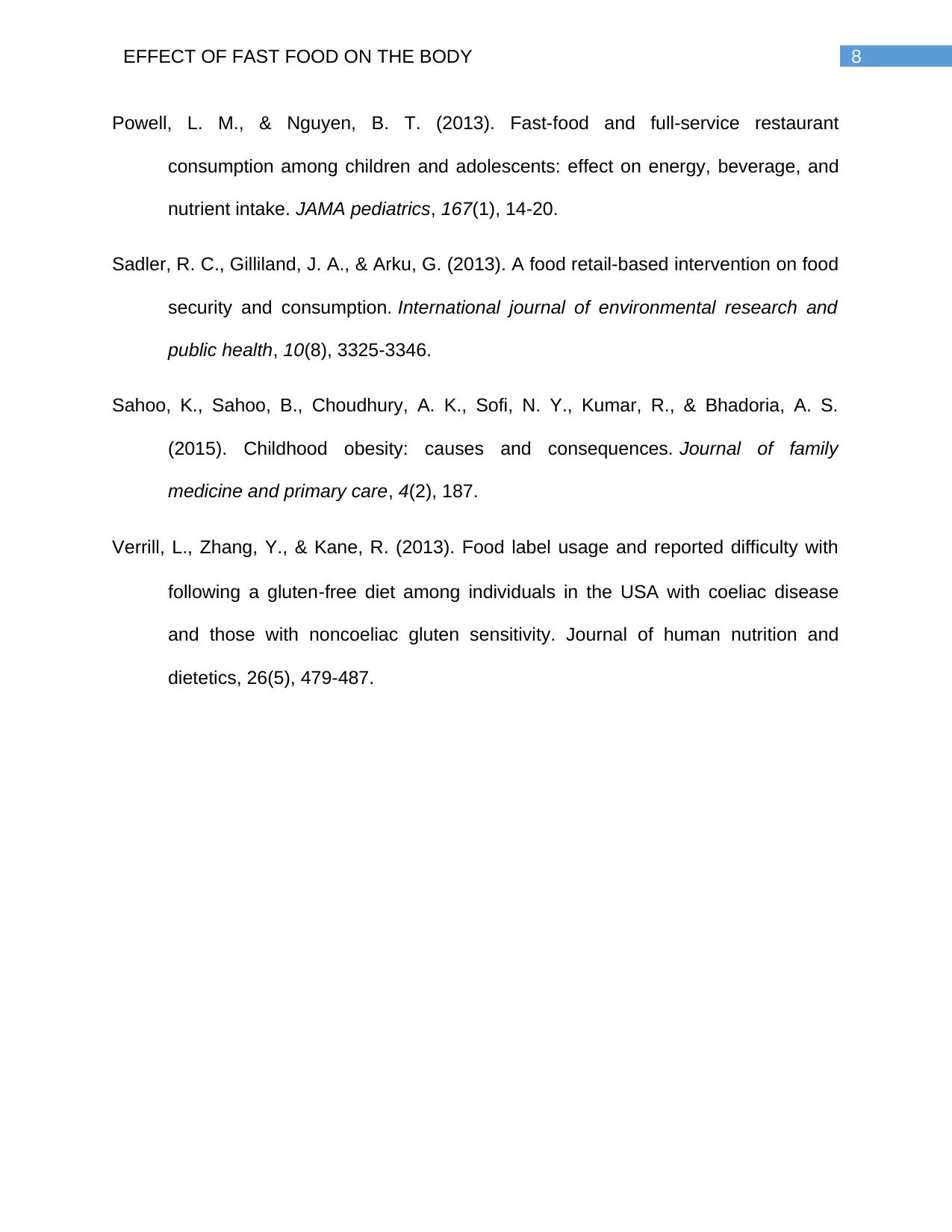
8EFFECT OF FAST FOOD ON THE BODY
Powell, L. M., & Nguyen, B. T. (2013). Fast-food and full-service restaurant
consumption among children and adolescents: effect on energy, beverage, and
nutrient intake. JAMA pediatrics, 167(1), 14-20.
Sadler, R. C., Gilliland, J. A., & Arku, G. (2013). A food retail-based intervention on food
security and consumption. International journal of environmental research and
public health, 10(8), 3325-3346.
Sahoo, K., Sahoo, B., Choudhury, A. K., Sofi, N. Y., Kumar, R., & Bhadoria, A. S.
(2015). Childhood obesity: causes and consequences. Journal of family
medicine and primary care, 4(2), 187.
Verrill, L., Zhang, Y., & Kane, R. (2013). Food label usage and reported difficulty with
following a gluten‐free diet among individuals in the USA with coeliac disease
and those with noncoeliac gluten sensitivity. Journal of human nutrition and
dietetics, 26(5), 479-487.
Powell, L. M., & Nguyen, B. T. (2013). Fast-food and full-service restaurant
consumption among children and adolescents: effect on energy, beverage, and
nutrient intake. JAMA pediatrics, 167(1), 14-20.
Sadler, R. C., Gilliland, J. A., & Arku, G. (2013). A food retail-based intervention on food
security and consumption. International journal of environmental research and
public health, 10(8), 3325-3346.
Sahoo, K., Sahoo, B., Choudhury, A. K., Sofi, N. Y., Kumar, R., & Bhadoria, A. S.
(2015). Childhood obesity: causes and consequences. Journal of family
medicine and primary care, 4(2), 187.
Verrill, L., Zhang, Y., & Kane, R. (2013). Food label usage and reported difficulty with
following a gluten‐free diet among individuals in the USA with coeliac disease
and those with noncoeliac gluten sensitivity. Journal of human nutrition and
dietetics, 26(5), 479-487.
⊘ This is a preview!⊘
Do you want full access?
Subscribe today to unlock all pages.

Trusted by 1+ million students worldwide
1 out of 9
Related Documents
Your All-in-One AI-Powered Toolkit for Academic Success.
+13062052269
info@desklib.com
Available 24*7 on WhatsApp / Email
![[object Object]](/_next/static/media/star-bottom.7253800d.svg)
Unlock your academic potential
Copyright © 2020–2025 A2Z Services. All Rights Reserved. Developed and managed by ZUCOL.





